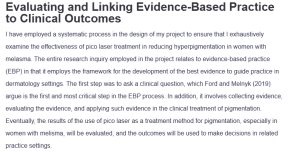Evaluating and Linking Evidence-Based Practice to Clinical Outcomes
I have employed a systematic process in the design of my project to ensure that I exhaustively examine the effectiveness of pico laser treatment in reducing hyperpigmentation in women with melasma. The entire research inquiry employed in the project relates to evidence-based practice (EBP) in that it employs the framework for the development of the best evidence to guide practice in dermatology settings. The first step was to ask a clinical question, which Ford and Melnyk (2019) argue is the first and most critical step in the EBP process. In addition, it involves collecting evidence, evaluating the evidence, and applying such evidence in the clinical treatment of pigmentation. Eventually, the results of the use of pico laser as a treatment method for pigmentation, especially in women with melisma, will be evaluated, and the outcomes will be used to make decisions in related practice settings.
There are several practice improvement outcomes this project is expected to accomplish. Firstly, the inquiry is aimed at presenting evidence on laser therapy as a safe and effective alternative to topical medications in the treatment of pigmentary disorders such as melasma. Pigmentary disorders such as melasma have a high risk of recurrence with topical medications such as hydroquinone (Ko et al., 2023). The inquiry will validate the effectiveness of pico laser therapy in preventing such recurrence. Melasma and hyperpigmentation disorders are linked to poor mental health outcomes and low quality of life (Platsidaki et al., 2023). By effectively eliminating melasma and hyperpigmentation, the project will improve patient’s self-esteem, confidence, and overall quality of life. Additionally, by reducing the risk of recurrence, project outcomes will improve the cost-effectiveness of managing hyperpigmentation in women with pigmentary disorders.
The capstone project will be evaluated based on various patient outcome metrics with a focus on the efficacy and safety of pico laser treatment when used as a treatment modality in women with melasma to reduce hyperpigmentation and patient experiences. Therefore, quantitative and qualitative data analysis methods will be utilized to analyze data on objective and subjective outcomes.
References
Ford, L. G., & Melnyk, B. M. (2019). The underappreciated and misunderstood PICOT question: A critical step in the EBP process. Worldviews on Evidence-Based Nursing, 16(6), 422–423. https://doi.org/10.1111/wvn.12408
Ko, D., Wang, R. F., Ozog, D., Lim, H. W., & Mohammad, T. F. (2023). Disorders of hyperpigmentation. Part II. Review of management and treatment options for hyperpigmentation. Journal of the American Academy of Dermatology, 88(2), 291–320. https://doi.org/10.1016/J.JAAD.2021.12.065
Platsidaki, E., Efstathiou, V., Markantoni, V., Kouris, A., Kontochristopoulos, G., Nikolaidou, E., Rigopoulos, D., Stratigos, A., & Gregoriou, S. (2023). Self-esteem, depression, anxiety and quality of life in patients with melasma living in a sunny Mediterranean area: Results from a prospective cross-sectional study. Dermatology and Therapy, 13(5), 1127–1136. https://doi.org/10.1007/S13555-023-00915-1/TABLES/3
ORDER A PLAGIARISM-FREE PAPER HERE
We’ll write everything from scratch
Question 
Discussion Prompt
- Discuss how your research inquiry relates to evidence-based practice. What practice improvement outcomes do you expect your inquiry to accomplish? How do you intend to evaluate your capstone project?
Expectations
- • Length: A minimum of 275 words, not including references
- • Citations: At least one high-level scholarly reference in APA from within the last 5 years

Evaluating and Linking Evidence-Based Practice to Clinical Outcomes
